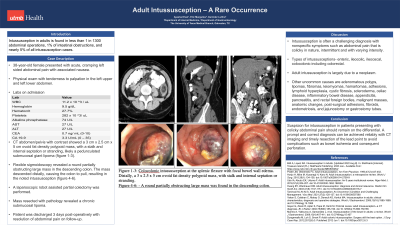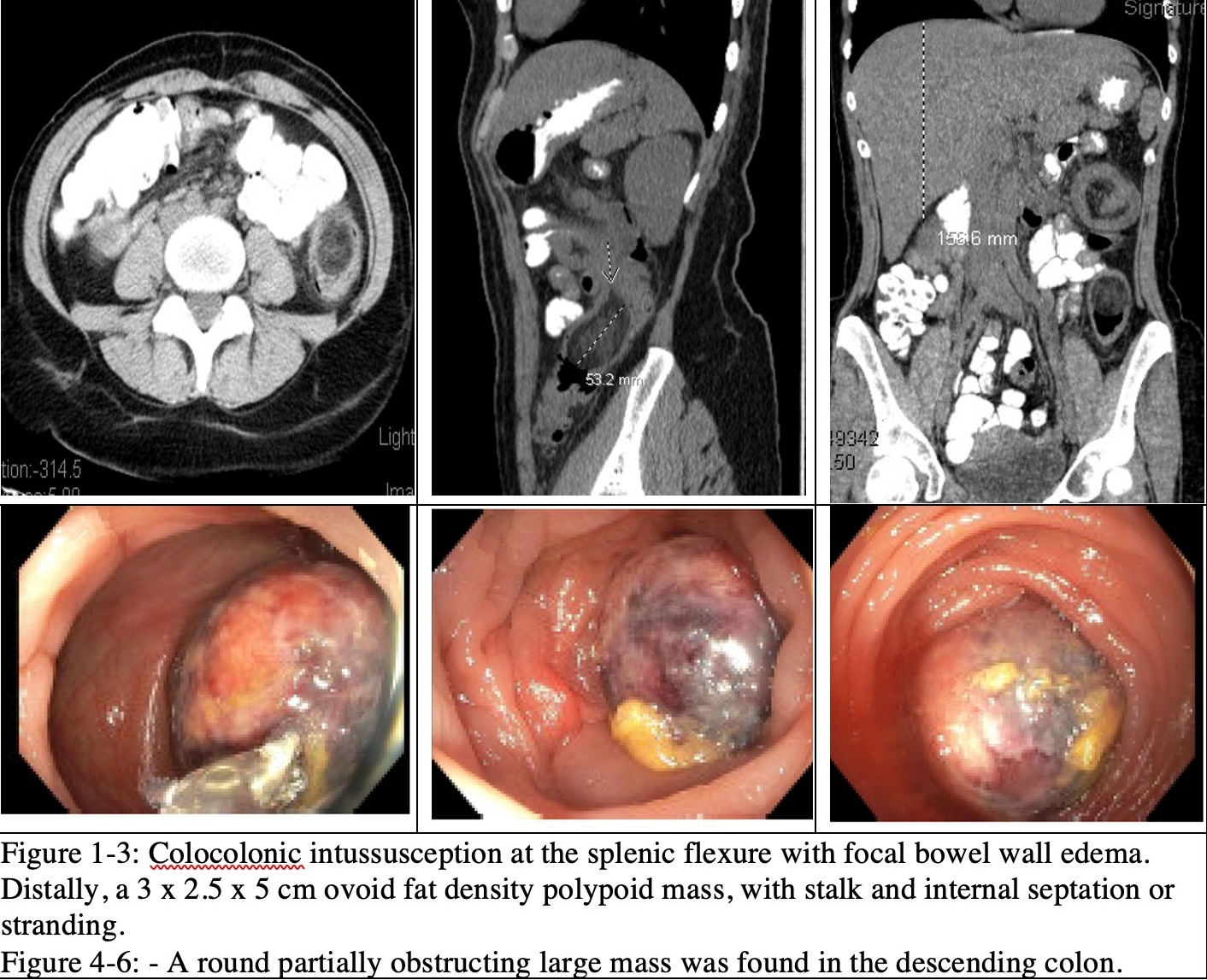Monday Poster Session
Category: Colon
P1680 - Adult Intussusception: A Rare Occurrence
Monday, October 23, 2023
10:30 AM - 4:15 PM PT
Location: Exhibit Hall

Has Audio
- AK
Ayesha Khan, DO
University of Texas Medical Branch
Galveston, TX
Presenting Author(s)
Ayesha Khan, DO1, Eric Margulies, MD1, Gurinder Luthra, DO2
1University of Texas Medical Branch, Galveston, TX; 2UTMB, Galveston, TX
Introduction: Intussusception in adults is extremely rare, found in less than 1 in 1300 abdominal operations, 1% of intestinal obstructions, and nearly 5% of all intussusception cases. We report a case of a 38-year-old female with colo-colonic intussusception at the splenic flexure due to a large lipoma as the leading point.
Case Description/Methods: A 38-year-old female presented with acute, cramping left sided abdominal pain with associated nausea. On physical exam, patient had tenderness to palpation in the left upper and left lower abdomen. Laboratory results on admission showed a mild leukocytosis (11.45x10^3) with otherwise normal liver function tests, complete blood count, and basic metabolic panel. Computed tomography (CT) abdomen/pelvis with contrast showed a 3 cm x 2.5 cm x 5 cm ovoid fat density polypoid mass, with a stalk and internal septation or stranding, likely a pedunculated submucosal giant lipoma (figure 1-3). Flexible sigmoidoscopy was performed, revealed a round partially obstructing large mass in the descending colon. The mass descended distally, causing the colon to pull, resulting in the noted intussusception (figure 4-6). With the noted CT and endoscopic findings, colorectal surgery was consulted. A laparoscopic robot assisted partial colectomy was performed. The mass was resected, with pathology revealing a chronic submucosal lipoma. Patient was discharged 3 days post-operatively with resolution of abdominal pain on follow-up.
Discussion: Intussusception is often a challenging diagnosis with nonspecific symptoms. The most common symptom associated with intussusception is vague abdominal pain described as colicky in nature, intermittent and with varying intensity. Types of intussusceptions include enteric, ileocolic, ileocecal, colocolonic including colorectal. Adult intussusception is largely due to a neoplasm. However, other uncommon causes are adenomatous polyps, lipomas, fibromas, leiomyomas, hamartomas, adhesions, lymphoid hyperplasia, cystic fibrosis, scleroderma, celiac disease, inflammatory bowel disease, appendicitis, pancreatitis, and rectal foreign bodies, malignant masses, anatomic changes, post-surgical adhesions, fibroids, endometriosis, and jejunostomy or gastrostomy tubes. Suspicion for intussusception in patients presenting with colicky abdominal pain should remain on the differential. A prompt and correct diagnosis can be achieved reliably with CT imaging and timely resection of the lead point to avoid complications such as bowel ischemia and consequent perforation.

Disclosures:
Ayesha Khan, DO1, Eric Margulies, MD1, Gurinder Luthra, DO2. P1680 - Adult Intussusception: A Rare Occurrence, ACG 2023 Annual Scientific Meeting Abstracts. Vancouver, BC, Canada: American College of Gastroenterology.
1University of Texas Medical Branch, Galveston, TX; 2UTMB, Galveston, TX
Introduction: Intussusception in adults is extremely rare, found in less than 1 in 1300 abdominal operations, 1% of intestinal obstructions, and nearly 5% of all intussusception cases. We report a case of a 38-year-old female with colo-colonic intussusception at the splenic flexure due to a large lipoma as the leading point.
Case Description/Methods: A 38-year-old female presented with acute, cramping left sided abdominal pain with associated nausea. On physical exam, patient had tenderness to palpation in the left upper and left lower abdomen. Laboratory results on admission showed a mild leukocytosis (11.45x10^3) with otherwise normal liver function tests, complete blood count, and basic metabolic panel. Computed tomography (CT) abdomen/pelvis with contrast showed a 3 cm x 2.5 cm x 5 cm ovoid fat density polypoid mass, with a stalk and internal septation or stranding, likely a pedunculated submucosal giant lipoma (figure 1-3). Flexible sigmoidoscopy was performed, revealed a round partially obstructing large mass in the descending colon. The mass descended distally, causing the colon to pull, resulting in the noted intussusception (figure 4-6). With the noted CT and endoscopic findings, colorectal surgery was consulted. A laparoscopic robot assisted partial colectomy was performed. The mass was resected, with pathology revealing a chronic submucosal lipoma. Patient was discharged 3 days post-operatively with resolution of abdominal pain on follow-up.
Discussion: Intussusception is often a challenging diagnosis with nonspecific symptoms. The most common symptom associated with intussusception is vague abdominal pain described as colicky in nature, intermittent and with varying intensity. Types of intussusceptions include enteric, ileocolic, ileocecal, colocolonic including colorectal. Adult intussusception is largely due to a neoplasm. However, other uncommon causes are adenomatous polyps, lipomas, fibromas, leiomyomas, hamartomas, adhesions, lymphoid hyperplasia, cystic fibrosis, scleroderma, celiac disease, inflammatory bowel disease, appendicitis, pancreatitis, and rectal foreign bodies, malignant masses, anatomic changes, post-surgical adhesions, fibroids, endometriosis, and jejunostomy or gastrostomy tubes. Suspicion for intussusception in patients presenting with colicky abdominal pain should remain on the differential. A prompt and correct diagnosis can be achieved reliably with CT imaging and timely resection of the lead point to avoid complications such as bowel ischemia and consequent perforation.

Figure: Figure 1-3: Colocolonic intussusception at the splenic flexure with focal bowel wall edema. Distally, a 3 x 2.5 x 5 cm ovoid fat density polypoid mass, with stalk and internal septation or stranding.
Figure 4-6: - A round partially obstructing large mass was found in the descending colon.
Figure 4-6: - A round partially obstructing large mass was found in the descending colon.
Disclosures:
Ayesha Khan indicated no relevant financial relationships.
Eric Margulies indicated no relevant financial relationships.
Gurinder Luthra indicated no relevant financial relationships.
Ayesha Khan, DO1, Eric Margulies, MD1, Gurinder Luthra, DO2. P1680 - Adult Intussusception: A Rare Occurrence, ACG 2023 Annual Scientific Meeting Abstracts. Vancouver, BC, Canada: American College of Gastroenterology.
